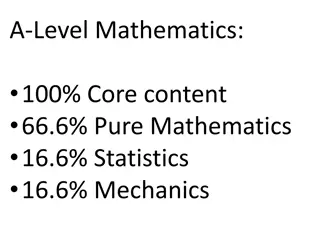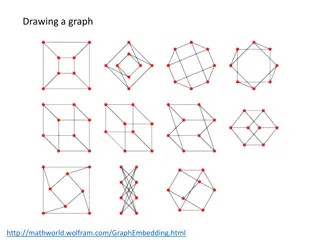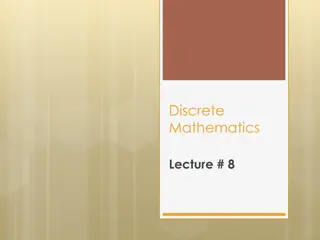Basic Graph Terminology in Discrete Mathematics
Exploring the fundamental definitions in graph theory including adjacent vertices, neighborhoods, degrees of vertices, isolated and pendant vertices. Examples are provided to illustrate the concepts.
Download Presentation

Please find below an Image/Link to download the presentation.
The content on the website is provided AS IS for your information and personal use only. It may not be sold, licensed, or shared on other websites without obtaining consent from the author.If you encounter any issues during the download, it is possible that the publisher has removed the file from their server.
You are allowed to download the files provided on this website for personal or commercial use, subject to the condition that they are used lawfully. All files are the property of their respective owners.
The content on the website is provided AS IS for your information and personal use only. It may not be sold, licensed, or shared on other websites without obtaining consent from the author.
E N D
Presentation Transcript
Discrete Mathematics Basic Graph Terminology Part -1
BASIC GRAPH TERMINOLOGY Definition 1: Two vertices ? and ? in an undirected graph G are called adjacent (or neighbors) in G if u and v are endpoints of an edge ? of G. Such an edge ? is called incident with the vertices ? and ? and ? is said to connect ? and ?. edge (?,?) ? ? 2
BASIC GRAPH TERMINOLOGY Definition 2: The set of all neighbors of a vertex ? of ? = (?,?), denoted by ?(?), is called the neighborhood of ?. If ? is a subset of ?, we denote by ?(?) the set of all vertices in ? that are adjacent to at least one vertex in ?. So, ?(?) = ? ?? ? . = ?,? = ?,?,?,? = ?,?,?,? = ? = ?,?,? = ?,?,?,? ? ? = ? ? ? ? ? ? ? ? ? ? ? ? 3
BASIC GRAPH TERMINOLOGY Definition 3: The degree of a vertex in an undirected graph is the number of edges incident with it, except that a loop at a vertex contributes twice to the degree of that vertex. The degree of the vertex v is denoted by deg(v). deg(?) = 2 deg(?) = 4 deg(?)= 4 deg(?) = 1 deg(?) = 3 deg(?) = 4 deg(g)= 0 4
BASIC GRAPH TERMINOLOGY Isolated: A vertex of degree zero is called isolated. It follows that an isolated vertex is not adjacent to any vertex. Vertex g is isolated. deg(?) = 2 deg(?) = 4 deg(?)= 4 deg(?) = 1 deg(?) = 3 deg(?) = 4 deg(g)= 0 5
BASIC GRAPH TERMINOLOGY Pendant: Avertex is pendant if and only if it has degree one. Vertex ? is pendant. deg(?) = 2 deg(?) = 4 deg(?)= 4 deg(?) = 1 deg(?) = 3 deg(?) = 4 deg(g)= 0 6
BASIC GRAPH TERMINOLOGY Example 1: What are the degrees and what are the neighborhoods of the vertices in the following graph? deg(?) = deg(?) = deg(?) = deg(?) = deg(?) = 7
BASIC GRAPH TERMINOLOGY Example 1: What are the degrees and what are the neighborhoods of the vertices in the following graph? deg(?) = 4 deg(?) = 6 deg(?)= 1 deg(?) = 5 deg(?) = 6 8
BASIC GRAPH TERMINOLOGY Example 1: What are the degrees and what are the neighborhoods of the vertices in the following graph? deg(?) = 4 deg(?) = 6 deg(?)= 1 deg(?) = 5 deg(?) = 6 Vertex ? is pendant 9
BASIC GRAPH TERMINOLOGY Example 1: What are the degrees and what are the neighborhoods of the vertices in the following graph? ?(?) = ?(?) = ?(?) = ?(?) = ?(?) = 10
BASIC GRAPH TERMINOLOGY Example 1: What are the degrees and what are the neighborhoods of the vertices in the following graph? ?(?) = {?,?,?} ?(?) = {?,?,?,?,?} ?(?) = ? ?(?) = {?,?,?} ?(?) = ?,?,? 11
BASIC GRAPH TERMINOLOGY Example 2: What are the degrees and what are the neighborhoods of the vertices in the following graph? Number of vertices = 5 Number of edges = 13 12
BASIC GRAPH TERMINOLOGY Example 2: What are the degrees and what are the neighborhoods of the vertices in the following graph? deg(?) = deg(?) = deg(?) = deg(?) = deg(?) = 13
BASIC GRAPH TERMINOLOGY Example 2: What are the degrees and what are the neighborhoods of the vertices in the following graph? deg(?) = 6 deg(?) = 6 deg(?)= 6 deg(?) = 5 deg(?) = 3 14
BASIC GRAPH TERMINOLOGY Example 2: What are the degrees and what are the neighborhoods of the vertices in the following graph? ?(?) = ?(?) = ?(?) = ?(?) = ?(?) = 15
BASIC GRAPH TERMINOLOGY Example 2: What are the degrees and what are the neighborhoods of the vertices in the following graph? ?(?) = {?,?,?} ?(?) = {?,?,?,?} ?(?) = ?,?,? ?(?) = {?,?,?} ?(?) = ?,?,? 16
BASIC GRAPH TERMINOLOGY The Handshaking Theorem: Let ? = (?, ?) be undirected graph with E edges. Then 2 E = deg(?) ? ? edge Edge having two endpoints and a handshakeinvolving two hands. 17
BASIC GRAPH TERMINOLOGY Example 3: How many edges are there in an undirected graph with 10 vertices each of degree six? 18
BASIC GRAPH TERMINOLOGY Example 3:Answer How many edges are there in a graph with 10 vertices each of degree six? 2 E = deg(?) ? ? Solution: Because the sum of the degrees of the vertices is 6 10 = 60, it follows that 2E = 60. Therefore, E = 30. 19
BASIC GRAPH TERMINOLOGY Definition 4: When (u, v) is an edge of the graph G with directed edges, u is said to be adjacent to v and v is said to be adjacent from u. The vertex u is called the initial vertex of (u, v), and v is called the terminal or end vertex of (u, v). The initial vertex and terminal vertex of a loop are the same. edge (u, v) ? ? 20
BASIC GRAPH TERMINOLOGY Definition 5: In a graph with directed edges the in-degree of a vertex ?, denoted by deg (?), is the number of edges with ? as their terminal vertex. The out-degree of ?, denoted by deg+(?), is the number of edges with ? as their initial vertex. (Note that a loop at a vertex contributes 1 to both the in- degree and the out-degree of this vertex.) 21
BASIC GRAPH TERMINOLOGY Example 4: Number of vertices = Number of edges = deg (?) = deg (?) = deg (?) = deg (?) = deg (?) = deg (?) = deg+(?) = deg+(?) = deg+(?) = deg+(?) = deg+(?) = deg+(?) = 22
BASIC GRAPH TERMINOLOGY Example 4: Number of vertices = 6 Number of edges = 12 deg (?) = 2 deg (?) = 2 deg (?) = 3 deg (?) = 2 deg (?) = 3 deg (?) = 0 deg+(?) = 4 deg+(?) = 1 deg+(?) = 2 deg+(?) = 2 deg+(?) = 3 deg+(?) = 0 23
BASIC GRAPH TERMINOLOGY Theorem3: 24
BASIC GRAPH TERMINOLOGY Example 4: Recall: Number of vertices = 6 Number of edges = 12 deg (?) = 2 deg (?) = 2 deg (?) = 3 deg (?) = 2 deg (?) = 3 deg (?) = 0 deg+(?) = deg+(?) = deg+(?) = deg+(?) = deg+(?) = deg+(?) = 4 1 2 2 3 0 25




























